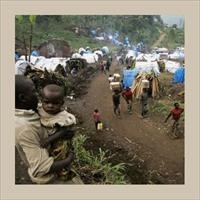WHO and health partners lead massive cholera response in eastern Democratic Republic of the Congo

WHO and health partners have launched an intensive operation to prevent and control the increase in the number of cholera cases, which have tripled in some areas to 150 a week, amid the recent escalation of violence in the eastern part of the Democratic Republic of the Congo.
Insecurity, massive population displacement (at least 250 000 people since early August), weak health services and a lack of safe water and proper sanitation facilities have caused a marked increase in the number of people with cholera in North and South Kivu.
As yet no data is available on the number of deaths linked to the current outbreak, but generally in complex emergencies the case fatality rate can surpass 30%. In 1994, some 50 000 people died from a combined epidemic of cholera and dysentery linked to the Rwandan exodus into Goma, the main town of North Kivu.
There has been a tripling of cholera cases since the start of October to early November in the Goma health zone, which includes the area of Karisimbi. From July-August, there was a weekly incidence of less than 20 cases in Goma. But in the first week of October, there were 40 cholera cases, which increased to about 150 in early November.
"Such an increase of cases in a region that is already endemic for cholera is an early warning sign of a potentially larger epidemic, and all health providers are working together to ensure that we do not see a repeat of 1994," said Dr Eric Laroche, Assistant Director-General for WHO's Health Action in Crises.
In all of North Kivu, there have been at least 997 cholera cases reported in that time, with most recorded in Rutshuru (466), Goma (263) and Karisimbi (145). In South Kivu during the same period, 855 cholera cases have been reported, with most in Minova (371).
Cholera is a water-borne bacterial disease characterized by acute watery diarrhoea and vomiting and can rapidly lead to death if untreated. It is mainly transmitted through contaminated water and food and is closely linked to inadequate sanitation. It is endemic in the eastern part of the country and that has alerted the population and health providers of cholera's presence, risks and response.
"There is high awareness of the deadly impact that cholera, and many other communicable illnesses such as malaria and measles, have on populations in the eastern part of the Democratic Republic of the Congo," Dr Laroche said. "But this additional risk is unacceptable. Access to safe water, proper sanitation and health services is essential to prevent it from spreading to those displaced on roads, residing in temporary camps and living in established communities."
Health sector response to increasing needs
WHO is leading the coordinated health response to the emergency. All concerned health providers and agencies coordinate their efforts through a group known as the Health Cluster.
WHO is buying and delivering large quantities of medical supplies, including materials to treat cholera and other water-borne diseases, in the affected areas of the country. Supplies are being provided to MSF Switzerland in the northern town of Dungu, where separate fighting has impacted the health of the community.
Sixty tonnes of medicines have arrived by plane into Kampala, the capital of neighbouring Uganda, a large portion of which is due to leave by road on Saturday, 15 November for Goma. The consignment includes Oral Rehydration Salts that can treat successfully up to 80% of suspect cholera cases, as well as intravenous fluids and antibiotics for handling severe cases.
WHO has more than a dozen staff in the area, including epidemiologists, who are working to strengthen the reporting system for cholera and other potentially life-threatening diseases, including measles and malaria. Malaria is a major killer in this part of the country, being responsible for 45% of infant mortality.
 Back and Next - Back and Next
Back and Next - Back and Next See Also - See Also
See Also - See Also